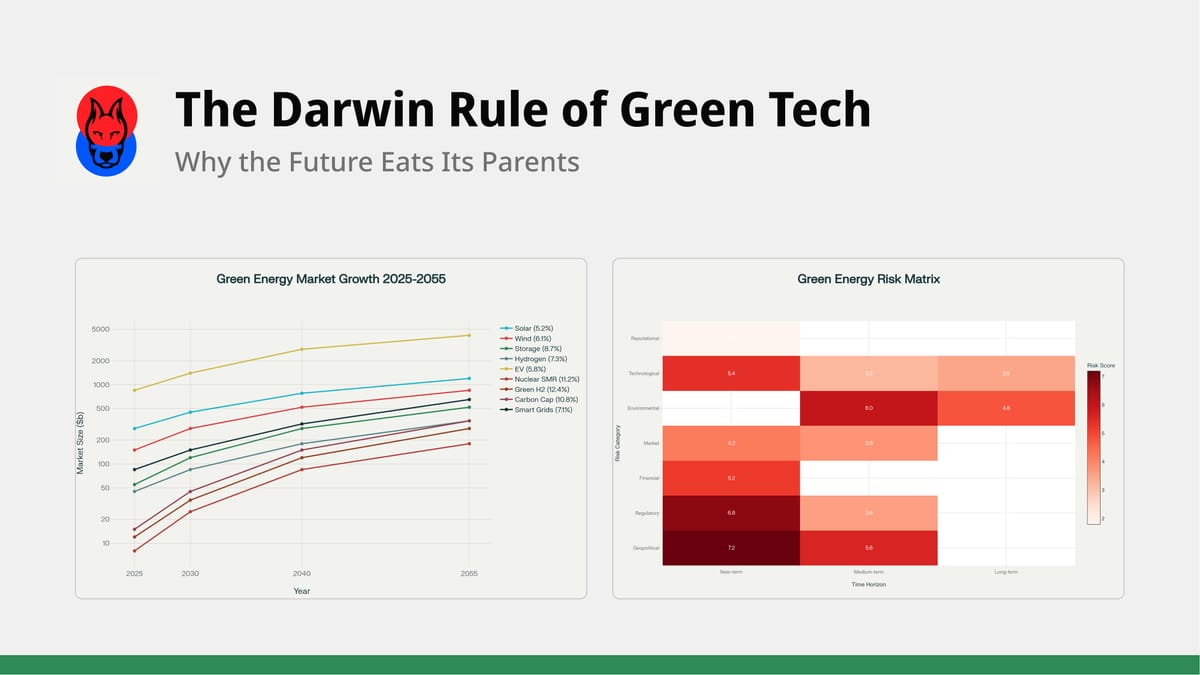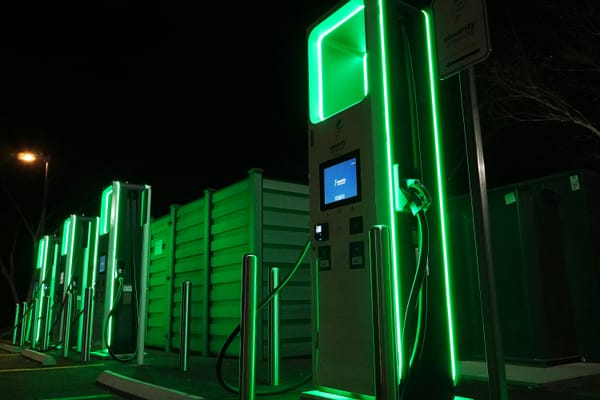The Darwin Rule of Green Tech: Why the Future Eats Its Parents
Technological Disruption Risk Across Green Energy and Storage Sectors Date: October 2025

The Rule
The green economy doesn’t evolve — it mutates.
Survival in this market isn’t about stability or scale.
It’s about creative self-destruction — killing your own technology before someone else does.
At Doberman VC, we call it The Darwin Rule:
“Those who disrupt themselves first, survive longest.”
Every current leader in clean energy — solar, battery, grid tech — is standing on a cliff built from its own success. The next innovation wave won’t compete with them; it will consume them.
1. The Perovskite Threat: Silicon’s Last Stand
For twenty years, crystalline silicon was the unshakable foundation of solar power.
Then came perovskites — a material so light, so efficient, and so cheap that it could turn today’s solar giants into fossils.
Perovskites promise over 25–30% efficiency, printable manufacturing, and flexibility no silicon wafer can match. If — or rather when — they stabilize commercially, companies like Jinko, Canadian Solar, and Trina will face an existential collapse.
Some incumbents understand this Darwinian law.
First Solar and Enphase are already pouring capital into thin-film and hybrid perovskite research, trying to reinvent themselves before the market does it for them.
This isn’t “innovation.” It’s survival by self-destruction — the Apple-iPod moment of the energy world.
2. Solid-State Batteries: The Quiet Extinction Event
In the energy storage race, a similar drama is unfolding.
Solid-state batteries are not an upgrade — they’re a regime change.
Imagine a cell that doubles energy density, cuts fire risk to near-zero, and charges in minutes.
That’s what QuantumScape, Solid Power, Toyota, and Panasonic are building toward — with commercialization targets circling 2027.
If one of them succeeds, the result will be brutal.
Legacy lithium producers — LG Energy Solution, CATL, BYD — could see entire product lines become obsolete overnight.
What’s coming isn’t market competition.
It’s a technological extinction event disguised as progress.
3. The Investor’s Playbook: Balance Between Evolution and Erosion
For investors, this landscape demands discipline.
You can’t overcommit to legacy giants — but you can’t abandon them either.
At Doberman VC, we approach this through a dual-structure allocation mindset:
The foundation stays with mature, cashflow-positive innovators — the Enphases and First Solars that can afford to reinvent themselves.
The exposure goes to high-risk, high-leverage disruptors — the QuantumScapes and Solid Powers of the frontier.
In essence: the old guard pays for your survival, the new blood pays for your future.
That’s not diversification. That’s Darwinian risk management.
4. Reading the Signals: Patents Speak Before Prices
The next revolution in energy won’t be visible in stock charts — it will first appear in patent databases.
That’s why we track:
• Emerging perovskite and solid-state patent clusters across the US, China, and Japan
• Shifts in R&D spend in annual reports and SEC filings
• Strategic partnerships between materials labs and public manufacturers
• ETF rebalancing into “green frontier” categories before the news cycle reacts
Every paradigm shift leaves a data trail.
Our OSINT models read those footprints long before headlines catch up.
Key Insights for 2025–2027
• The clean-tech sector doesn’t reward loyalty — it rewards mutation.
• Perovskites and solid-state batteries represent trillion-dollar redistributions, not growth stories.
• Most incumbents will try to protect their margins instead of killing their products — and that’s exactly how they’ll die.
• Investors must think like predators, not collectors: track signals, not narratives.
Conclusion: Evolution Has No Comfort Zone
In green technology, obsolescence isn’t a risk — it’s a destiny.
Every dominant company today is a future victim of the very innovation it once pioneered.
The only way out is forward.
Kill your own technology before the market kills you.
That’s the law of survival in the age of renewable disruption.
That’s the Darwin Rule of Green Tech.
Doberman VC — OSINT Intelligence for Capital
We identify technological inflection points before they reshape markets.
Follow our research for strategic foresight on AI, energy, and industrial evolution.





